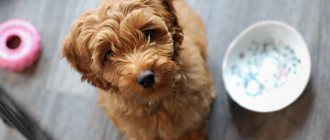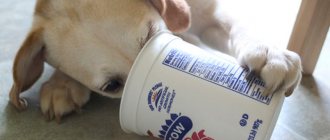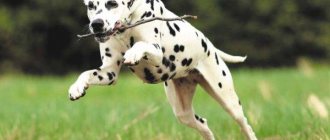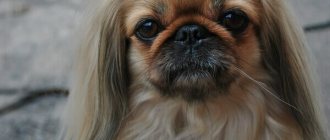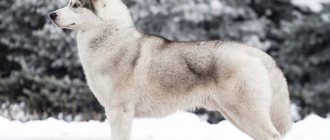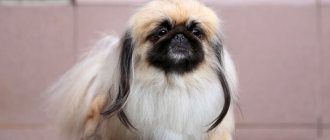Principles of feeding the breed
Dogs considered sacred animals of Chinese emperors, the short-legged and cute Pekingese are predisposed to many diseases. They are prone to excess weight, arthritis and arthrosis, pathologies of the eyes and teeth. Therefore, when planning your pet’s diet, consider the following recommendations:
- Food is served warm; cold food has a negative effect on the digestive system.
- An equal time pause is taken between meals; this stabilizes the functioning of the gastrointestinal tract.
- The bowl should be in a familiar, comfortable place. It is accessible to the animal at any time and is not disturbed there.
- Be sure to control the volume of portions, calculate it according to the weight and age of your pet. Representatives of the breed do not know any sense of proportion.
- Serve food in semi-liquid or thick form; simple broths will be uncomfortable for pets to eat; their muzzle is flat.
- Weak canines do not allow such dogs to easily chew hard food or dry food. It is better to give food in small pieces, soak the granules in water.
- Your pet should always have fresh water to drink; it is changed 2-3 times a day.
- If the animal rejects a certain food, remove the bowl for a while. A hungry dog will stop being capricious.
You need to draw up a nutrition plan based on the physiological characteristics (pregnancy, estrus, age) and the activity of the dog.
What type of food should I choose?
The dilemma facing all new dog owners is what to feed: homemade or commercial food. The decision is up to the owners, since each option has its own strengths and weaknesses.
► Features of the finished feed are that:
- Its composition is balanced, it already includes enough meat, vegetables, grains, vitamin and mineral supplements. You don't have to worry about additional dietary supplements.
- There are many lines, including for allergy sufferers, dogs with sensitive digestion, puppies or seniors.
- A large selection allows you to choose an option for any budget.
- You don’t need to prepare food, take care of its freshness, or store it - this saves time.
- Industrial food is easy to order online or buy in a store for future use; it is as accessible as possible.
One of the disadvantages here is that cheap feeds do not meet all quality requirements; they are made from recycled materials. Professional lines are above average. For some owners, the disadvantage is the fact that they do not know exactly what they are giving to their pet.
► Natural nutrition is good because:
- the owner is confident in the freshness and quality of the food;
- the pet receives a variety of food;
- This menu is cheaper.
In order for your dog to receive all the necessary substances, you will have to think through the diet and monitor its diversity, give additional vitamins, and independently calculate the serving size and approximate calorie content. Dishes must always be fresh, and their preparation takes time. It is more difficult to follow a diet on a natural diet.
What type of food should I choose?
Veterinarians and dog handlers have still not come to a consensus on what is better to feed the Pekingese: ready-made food or natural food.
Each approach has both advantages and disadvantages. But if you take a responsible approach to preparing the diet, your pet’s health will not suffer in both cases.
Important. Mixing two types of food is prohibited. A sudden change in menu causes indigestion, which is dangerous to health.
Ready-made dog food
Dry food for Pekingese must contain:
- natural meat, not offal;
- cereals and vegetables;
- vitamin and mineral supplements.
This composition will fully satisfy the body's nutritional needs.
Pekingese can be fed super premium or holistic products for small long-haired breeds. When choosing, take into account the individual characteristics of the pet:
- weight;
- age;
- presence of illness or pregnancy.
There are hypoallergenic and medicinal lines designed for dogs with various diseases. They help normalize the functioning of internal organs, strengthen the immune system and correct weight.
Most owners feed adult animals with the following brands:
- Orijen;
- ProPlan;
- GoldenEagle;
- Bosch;
- Acana;
- Piccolo;
- GO! NATURAL Holistic;
- Grandorf.
It is allowed to alternate wet canned food and dry food. The former add variety to the daily menu and do not cause thirst, while the latter gently cleanse teeth of plaque.
Important. Pekingese are not suitable for food labeled “Active” and “Sport”. Because of them, sedentary dogs gain excess weight.
Natural products
The owner needs to make the natural diet varied. Otherwise, your pet will quickly get bored with the same food and begin to refuse food.
In addition, this way the dog will receive a maximum of useful substances, which will have a positive effect on its health and appearance.
What you are allowed to feed adult Pekingese at home:
- lean meat - beef, rabbit, chicken, turkey;
- offal - heart, tripe, chicken offal, kidneys, liver;
- sea fish - horse mackerel, mackerel, halibut, etc., except pollock;
- porridges – rice, buckwheat, millet, oatmeal;
- fermented milk products - kefir, cottage cheese, bifidok, yogurt without dyes and fillers;
- vegetables - fresh carrots and tomatoes, boiled zucchini, beets, cauliflower;
- greens - parsley, sprouted oats, lettuce;
- fruits - bananas, pears, nectarines, apples.
It should be noted that when switching to another type of nutrition, it is important to act gradually. For about 2 weeks, first replace ¼ portion, after 3-4 days 2/4, etc.
What to feed a Pekingese puppy?
The dog’s menu largely depends on age and changes especially often during the period from birth to one year. How many times a day to feed the Pekingese and what, we will consider in table No. 1.
| Months | Number of meals | Diet |
| Up to 1 | Every 2 hours | Mother's milk, in its absence - a specialized formula, from the 14th day complementary foods are introduced (liquid porridge, pureed or minced meat, cottage cheese, fermented milk products) |
| 1-2 | Once every 4 hours | The volume of formula decreases, and by two months it is completely abandoned. Complementary foods include pieces of meat, fruits, and vegetables. |
| 2-3 | 5 | Food according to age or natural food, a three-month-old puppy is given boiled yolk and cartilage every 3-4 days |
| 2-6 | 3 | With natural nutrition, raw meat and dry food for puppies are allowed for the first time |
| 6-8 | 2-3 | “Sushka” is still from the children’s line, homemade food is becoming closer to adult food |
| More than 8 | 2 | Nutrition, as for an adult dog, is prepared taking into account all recommendations |
From birth to one month
After birth, puppies must be fed breast milk. If the mother is not nearby or her lactation is not enough, the owners purchase a specialized formula that resembles baby food. It is sold in veterinary pharmacies, diluted according to the instructions and given from a bottle with a nipple for the first 1.5-2 weeks, then it can be poured into a shallow bowl.
Children's artificial nutrition is not suitable, the composition and calorie content are different. It also cannot fully replace cow's milk.
Formula-fed babies are introduced to complementary foods earlier: from 2 weeks. You can feed a one-month-old Pekingese puppy liquid porridge with water or light broth, meat purees, you can use ready-made jars for children: beef, turkey, veal, chicken, cottage cheese. Milk replacer also remains.
Up to six months
Dogs stop feeding formula at 2 months. By this age, complementary feeding has been introduced, then it only becomes more complex and varied, more cereals, vegetables, fermented milk products, and fruits appear. Gradually, food begins to be given in pieces. The diet for up to six months looks like this:
- At 8 weeks, the daily volume of food is 180 g, it is divided into 6 meals so as not to stretch or overload the stomach. With this regime, the baby will not experience hunger.
- At 12 weeks, yolks are added, and the single portion is almost doubled (50-60 g).
- At 4 months, offal (liver, hearts) is added to the menu. The proportion of fermented milk dishes increases as molars begin to grow.
- At six months, meat can be served raw; cartilage is allowed. The diet is similar to that of an adult, only there are more meals per day and smaller portions.
Up to 12 months
The diet of puppies older than 6 months is almost no different from an adult. The only difference is in the volume of food and the number of feedings. It must be taken into account that at this age milk ceases to be absorbed, so it is excluded from the diet.
The body continues to grow rapidly, so it must receive a sufficient amount of Ca and protein compounds. Otherwise, the bone skeleton develops poorly and muscle mass does not gain. When feeding “dry”, rulers for puppies are used; when feeding at home, it is recommended to give complex supplements. If you are still thinking about what kind of meat you can give your Pekingese at this age, use the list of products for adults.
Pekingese puppies: care and feeding
It happens that Pekingese puppies are born very weak, and they require not only the care of their mother dog, but also additional care from their owner.
But even if puppies are active from the very first hours of their lives, this does not exclude your help. Care for the lack or absence of milk in a bitch
Look at what a Pekingese puppy looks like at birth: does it have any external pathologies, is it active enough? Complicated childbirth can negatively affect his condition. Weakened newborn puppies often refuse to suckle milk, because this is also not an easy job that takes a lot of effort, especially if the dog has tight nipples.
It happens that a bitch completely loses milk for one reason or another, because not everyone knows how to feed a Pekingese after giving birth so that there is milk. Then the puppies have to be fed artificially: dry bitch milk or another substitute.
- You can use honey to feed puppies until they are 10-14 days old. To do this, dilute a teaspoon of honey in half a glass of water. After 2 weeks, the diet should be more nutritious.
- Puppies older than 2 weeks can be fed with rolled oats jelly. A tablespoon of ground rolled oats is poured into about 150 ml of water, after which the porridge is cooked until tender. Before feeding, rub it through a strainer and add milk or honey to it.
- By three weeks, puppies begin to be fed with cottage cheese, and after 3 weeks - with scraped meat.
Try to purchase bottles with a nipple and special stands so that the puppies are fed in an “automatic” mode, otherwise this procedure will take up a lot of your time.
When a puppy suckles its mother, it sets its own level of satiety. If you feed him, focus on the baby’s tummy: if it has become quite dense, and the puppy no longer sucks so willingly and literally falls asleep on the go, it means he is full.
Remember: when artificially feeding, all food should be warm, since cold food is practically not digestible, and only boiled water should be used to prepare the formula for feeding. Proper feeding of a Pekingese puppy is the key to its future health.
If your Pekingese puppy, despite all your efforts, sucks poorly and little, support him by injecting a nutritious “cocktail”. Every two hours, 0.7 ml of a mixture consisting of 1.5 ml of glucose solution (5%), 8 ml of isotonic sodium chloride solution and 0.5 ml of ascorbic acid is injected subcutaneously. Having gained strength after such nutrition, the Pekingese puppy will improve its appetite and begin to quickly gain weight.
My Pekingese puppy is 1 month old, what should I feed him at this age?
If the bitch has enough milk, and the Pekingese puppies are gaining weight well, then there is no need to feed them. And only from the age of one month can they be weaned from breastfeeding and taught to eat on their own. Why during this period? In nature, the bitch feeds the grown puppies with the food she has eaten, for which she regurgitates it. It happens instinctively.
If you allow your Pekingese, weakened by bearing and feeding puppies, to continue to feed his cubs, he can exhaust his body. Therefore, take care of complementary foods at this time. You can use sour-milk products, meat, and canned dog food. Don't forget about mineral and vitamin supplements.
What to feed an adult Pekingese?
When feeding an adult Pekingese, it is important to consider portion size. Determining the optimal volume is easy: take the number of grams corresponding to the weight of your pet, watch how the animal behaves. If he leaves food behind, reduce the amount; if he knocks the bowl and shows a feeling of hunger, increase the portion.
The main thing is to correctly formulate the diet with natural feeding. It should consist of 50% meat. If you take offal, then the share increases by 1/3, since their nutritional value is less.
- Meat is the basis of nutrition, given daily raw (if you are sure of the quality) or boiled. Beef, turkey, veal, chicken, rabbit, pork (lean) are used.
- 1 out of 4 days meat is replaced with fish. Fillets of sea creatures (mackerel, halibut) are best suited.
- Cereals are always present on the menu (20-40%). Use buckwheat, rolled oats, rice, millet.
- Give a yolk (chicken or goose, 2-3 quail) once a week. The product must be boiled.
- The daily amount of food should contain 20% vegetables. They are given boiled or raw. Carrots, zucchini, broccoli or cauliflower work well.
- Fruit is one of the favorite treats of these small dogs; an apple and a pear are suitable for reward.
- Fermented milk should be given once every 3-4 days: cottage cheese, kefir, natural yogurt.
- Supplement your dishes with herbs (parsley, lettuce).
Use different cereals, types of meat and fish in your diet. Then the pet will receive maximum nutrients.
Diet for an elderly pet
After 8 years, dogs need special care; aging processes begin in their bodies. You should adjust your diet according to the following:
- Food becomes soft as the strength of teeth decreases.
- Daily calorie intake is reduced. The pet moves less, and its tendency to become overweight needs to be controlled. Reduce the proportion of slow carbohydrates and increase the amount of vegetables.
- In order not to overload the stomach, increase the number of feedings to 4-5 times a day (the daily norm does not change).
Expert opinion
Kuzmenko Olga Olegovna
Information about the expert
Ask a Question
Consult your veterinarian about what supplements to give your dog. Elderly individuals need to maintain healthy bones and joints, vision, and hearing functions.
How to choose dry food for this breed?
If you decide to feed your Pekingese dog dry food, then you will think about which dry food is best for it? When choosing a line, pay attention to the composition, it should contain:
- meat (by-products, if present, then in minimal quantities, as an additive);
- vegetables;
- cereals;
- vitamin and mineral supplements.
Before purchasing, study the manufacturers' recommendations on the weight and age of the animals. Do not use rulers marked “Active”, they have a high caloric content and are not suitable for sedentary Pekingese.
Choose food from professional foods, including:
- Pro Plan.
- GO! NATURAL Holistic.
- Orijen.
- Acana.
- Bosch.
- Monge.
- Golden Eagle.
Let's briefly look at the features of several brands:
- Bosch mini adult is food for adult dogs of small breeds. The composition is designed so that the animal receives maximum energy value from a small portion volume. The structure and size of the granules are suitable for Pekingese teeth that are not very strong.
- Royal farm adult mini chicken. The product was created for dogs from 1 to 7 years old, supplemented with L-carnitine, which provides energy without increasing calories, and probiotics, which improve stomach function. An excellent option if your pet already has a tendency to be overweight.
- Pro Plan Small & Mini Adult is a whole line that includes food for animals with sensitive digestion, a product for sterilized (neutered) dogs, and allergy sufferers. Pro Plan Small & mini treats are also sold.
- Monge dog grain free mini. A distinctive feature of the food is the absence of grains; potatoes are used as carbohydrates. It contains a high protein content and is enriched with Omega 3 and Omega 6 elements, which improve the condition of the coat.
If your Pekingese is allergic to holistic dry food (highest class), consult your veterinarian, he will select a line for allergy sufferers.
Dry food
It’s not for nothing that ready-made dry food has gained popularity among most dog owners, including the Pekingese breed. The owner does not need to waste time preparing balanced food for the Pekingese. I just poured the food from the bag into the feeder and that’s it! But there are also some nuances here. It is very important to take a responsible approach to choosing food. Give preference to trusted manufacturers.
Read the information on the packaging carefully. Keep in mind that each organism is individual; a pet may refuse to eat food, even if other representatives of the same breed happily eat it. It is better to buy one package to understand the preferences of your four-legged friend.
Even if you decide that your Pekingese's diet will consist only of natural products, a growing dog needs a complex of vitamins and microelements. Natural food may not always provide everything a dog needs. Therefore, consult your veterinarian, perhaps he will suggest adding dry food to your diet, at least for a while. This type of nutrition is called mixed.
It is important not only how and what to feed the Pekingese, but also how many times a day.
If a baby is fed 6 times a day, then an adult Pekingese is fed 2 times. If the dog licks the feeder, then just increase the portion a little, but two meals is enough for him, do not feed the pet during the day. There should always be only a bowl of clean water available in the public domain.
Similar article: How long do Pekingese live on average and what does it depend on?
What to give during natural feeding?
We have already listed what to feed the Pekingese at home, but if you have recently become the owner of a dog, it will be difficult to create a menu yourself. We offer a possible weekly meal plan in Table No. 2.
| Day of the week | Morning | Evening |
| Monday | Raw beef with stewed zucchini and carrots | Chicken + cottage cheese with apple pieces |
| Tuesday | Halibut fillet with buckwheat | Stewed turkey liver with vegetables |
| Wednesday | Beef with rice porridge + yolk | Turkey with herbs and cheese |
| Thursday | Chicken heart with oatmeal | Beef lung stewed with vegetables and parsley |
| Friday | Buckwheat with pieces of rabbit meat | Rice porridge with apples and pears, cottage cheese |
| Saturday | Horse mackerel with rice | Turkey and vegetable stew |
| Sunday | Rice porridge with chicken fillet, quail egg | Rice with zucchini and carrots, add a spoonful of olive oil, kefir |
The share of meat, vegetables and cereals is calculated from the daily volume of food.
What to feed an aging Pekingese
At the age of 7-8 years, about 20-25% of vegetables and cereals are removed from the diet, protein products are added - a little more chicken or beef, light offal. It is necessary to exclude all foods that cause the dog even the slightest discomfort. You should contact your veterinarian so that he can do tests and help you choose the optimal menu.
It is also necessary to take care of vitamins for an aging dog. They should contain a lot of vitamins A, C and E, which protect against aging and help remove accumulated harmful substances.
What not to feed a Pekingese
Do I need to give my Pekingese extra vitamins and minerals?
If the dog does not eat dry food, its nutrition is supplemented with vitamin supplements. Up to 12 months they give daily. Then the active growth stage ends, and vitamins are taken in courses. You can add pharmaceutical products to the food, such as fish oil and Omega-3,-6 acids, B vitamins, and Calcium phosphate. Natural sources of minerals are:
- bran;
- meat and bone meal;
- crushed egg grains;
- Brewer's yeast;
- olive oil.
It is difficult to use all this correctly, in the right quantity, so experts recommend buying ready-made balanced dietary supplements. Multivitamins for small breeds are suitable. For older pets, purchase supplements with calcium, chondroitin and glucosamine.
What is it forbidden to feed Pekingese?
Dogs love table food, sweets and other unhealthy “treats”. Constant consumption of prohibited foods will lead to problems with the gastrointestinal tract, allergies and other pathologies. What is it prohibited to feed an adult Pekingese?
- fatty meat (pork, lamb);
- smoked, spicy food;
- sweets;
- sausages;
- canned food;
- legumes;
- potatoes, onions, garlic.
Pekingese are not allowed to chew on bones, as they can break their fangs. Special treats or cartilage are used to clean teeth.
Natural food
When the dog grows up, the question arises: what to feed the Pekingese to keep him healthy and cheerful? Typically, pet owners are divided into supporters of natural food and those who prefer to feed their pets dry food. The first ones are sure that ready-made food will not provide the dog with adequate nutrition.
Similar article: How to choose a beautiful and sonorous name for a Pekingese puppy
Such owners prefer to feed an adult Pekingese with meat. And there's nothing wrong with that. Only natural food should be balanced and varied. Meat products alone are not enough for animals. So what do Pekingese eat? How to properly feed natural food?
You can include porridge made from rice, buckwheat or millet in your pet’s menu. Feeding a Pekingese without fruits and vegetables will be incomplete. It would be good to accustom a little fidget even to fresh herbs: dill, parsley.
Recommendations from nutritionists
Proper nutrition has many nuances; expert advice will help you improve it.
- After six months, the puppies begin to shed their first coat and their coat changes to that of an adult. During this period, the menu is enriched with seaweed or seafood. They are contraindicated for younger dogs.
- The ratio of meat and vegetables varies depending on the time of year. In summer, the body needs more fiber, in winter - protein.
- The mobility of Pekingese depends on temperament. Active dogs need 600 Kcal per day, with a moderate lifestyle 400 Kcal is enough, with a sedentary life - 300 Kcal.
- The amount of buckwheat on the menu is limited; its excessive consumption can cause urolithiasis.
- Pekingese dogs need to be fed intensively after giving birth or during pregnancy. The volume of food increases by 15% weekly from the 30th day of pregnancy. Returns to normal after the mother stops feeding the puppies.
- Treats should be supplied in moderation, otherwise gourmets will refuse regular food.
We found out what is best to feed the Pekingese. Monitor your pet's diet from an early age and instill in him the rules of feeding. Then the pet will be healthy, and it will be easier for you to take care of it.


